People Management in Health and Social Care: Report and Analysis
VerifiedAdded on 2022/10/08
|10
|1837
|16
Report
AI Summary
This report examines key aspects of people management within the health and social care sector. It begins by defining organizational structure and culture, exploring their impact on employees, including job satisfaction and motivation. The report then delves into how personal differences affect individual performance and discusses various management styles, such as autocratic, paternalistic, and democratic approaches, along with their impact on employee behavior. Leadership styles, including coaching, participative, and democratic approaches, are analyzed in terms of their effect on staff morale, decision-making, and productivity. The benefits of flexible working practices for both employers and employees are highlighted, along with the influence of the workplace environment on employee engagement and motivation. Ethical considerations in the workplace, corporate social responsibility, and various motivational theories, such as Hertzberg's and Maslow's, are also discussed. The report further explores strategies for improving employee performance, including training and development programs, recruitment and selection processes, and the importance of rewards and recognition. Finally, it emphasizes the interconnectedness of performance and productivity, highlighting the significance of learning, recognition, and flexible work hours in fostering a high-performing work environment. The report concludes by referencing relevant literature to support its analysis.
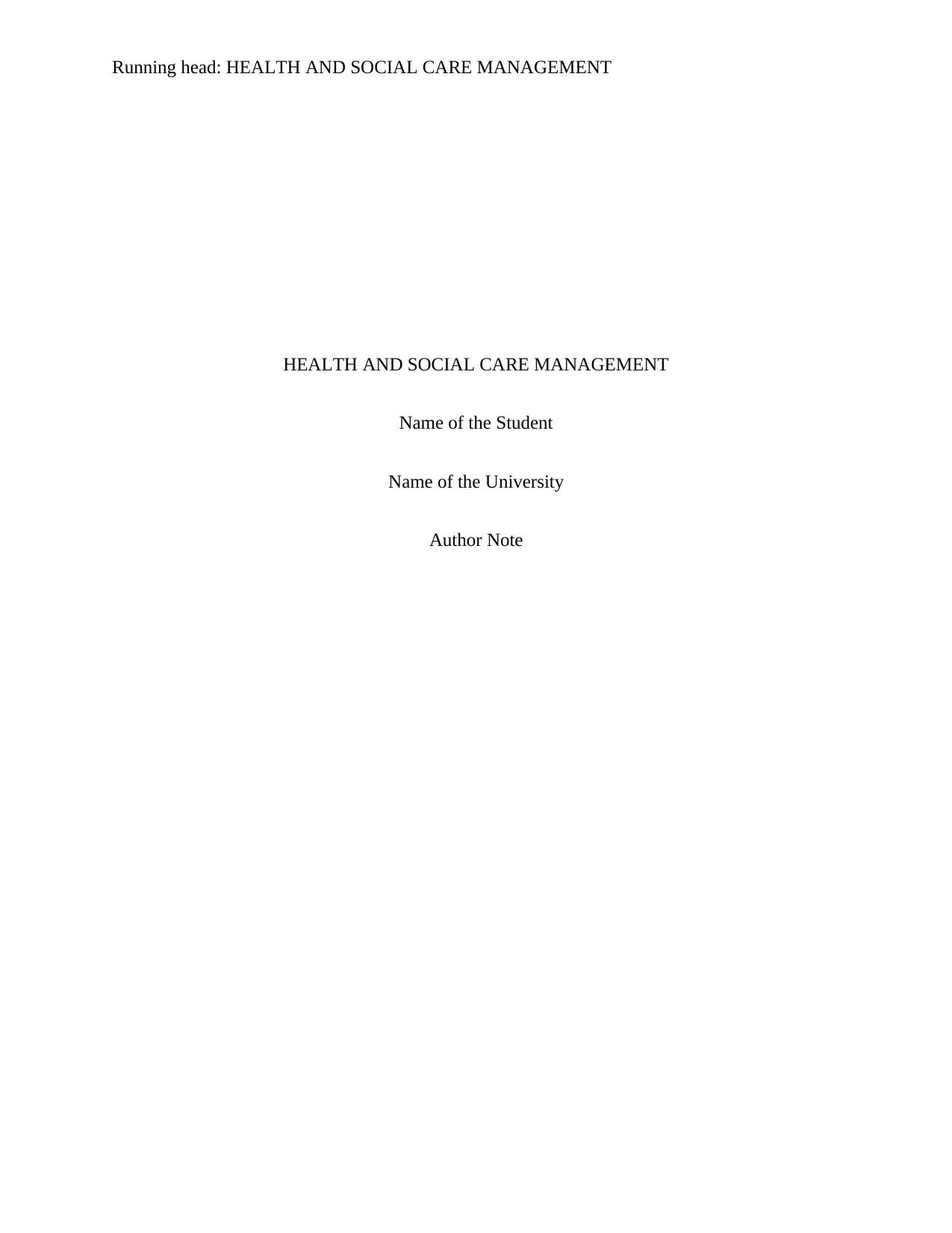
Running head: HEALTH AND SOCIAL CARE MANAGEMENT
HEALTH AND SOCIAL CARE MANAGEMENT
Name of the Student
Name of the University
Author Note
HEALTH AND SOCIAL CARE MANAGEMENT
Name of the Student
Name of the University
Author Note
Paraphrase This Document
Need a fresh take? Get an instant paraphrase of this document with our AI Paraphraser
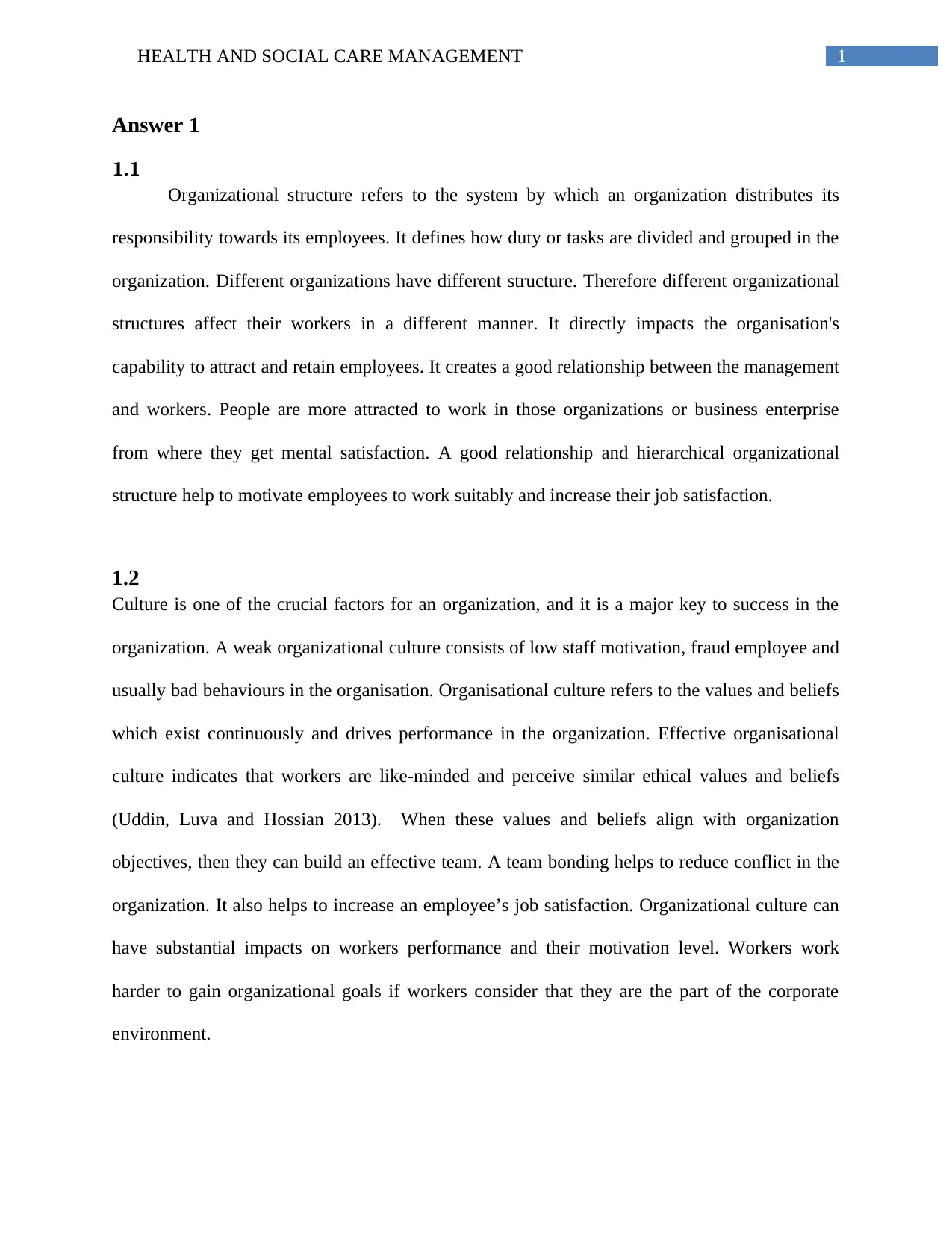
1HEALTH AND SOCIAL CARE MANAGEMENT
Answer 1
1.1
Organizational structure refers to the system by which an organization distributes its
responsibility towards its employees. It defines how duty or tasks are divided and grouped in the
organization. Different organizations have different structure. Therefore different organizational
structures affect their workers in a different manner. It directly impacts the organisation's
capability to attract and retain employees. It creates a good relationship between the management
and workers. People are more attracted to work in those organizations or business enterprise
from where they get mental satisfaction. A good relationship and hierarchical organizational
structure help to motivate employees to work suitably and increase their job satisfaction.
1.2
Culture is one of the crucial factors for an organization, and it is a major key to success in the
organization. A weak organizational culture consists of low staff motivation, fraud employee and
usually bad behaviours in the organisation. Organisational culture refers to the values and beliefs
which exist continuously and drives performance in the organization. Effective organisational
culture indicates that workers are like-minded and perceive similar ethical values and beliefs
(Uddin, Luva and Hossian 2013). When these values and beliefs align with organization
objectives, then they can build an effective team. A team bonding helps to reduce conflict in the
organization. It also helps to increase an employee’s job satisfaction. Organizational culture can
have substantial impacts on workers performance and their motivation level. Workers work
harder to gain organizational goals if workers consider that they are the part of the corporate
environment.
Answer 1
1.1
Organizational structure refers to the system by which an organization distributes its
responsibility towards its employees. It defines how duty or tasks are divided and grouped in the
organization. Different organizations have different structure. Therefore different organizational
structures affect their workers in a different manner. It directly impacts the organisation's
capability to attract and retain employees. It creates a good relationship between the management
and workers. People are more attracted to work in those organizations or business enterprise
from where they get mental satisfaction. A good relationship and hierarchical organizational
structure help to motivate employees to work suitably and increase their job satisfaction.
1.2
Culture is one of the crucial factors for an organization, and it is a major key to success in the
organization. A weak organizational culture consists of low staff motivation, fraud employee and
usually bad behaviours in the organisation. Organisational culture refers to the values and beliefs
which exist continuously and drives performance in the organization. Effective organisational
culture indicates that workers are like-minded and perceive similar ethical values and beliefs
(Uddin, Luva and Hossian 2013). When these values and beliefs align with organization
objectives, then they can build an effective team. A team bonding helps to reduce conflict in the
organization. It also helps to increase an employee’s job satisfaction. Organizational culture can
have substantial impacts on workers performance and their motivation level. Workers work
harder to gain organizational goals if workers consider that they are the part of the corporate
environment.
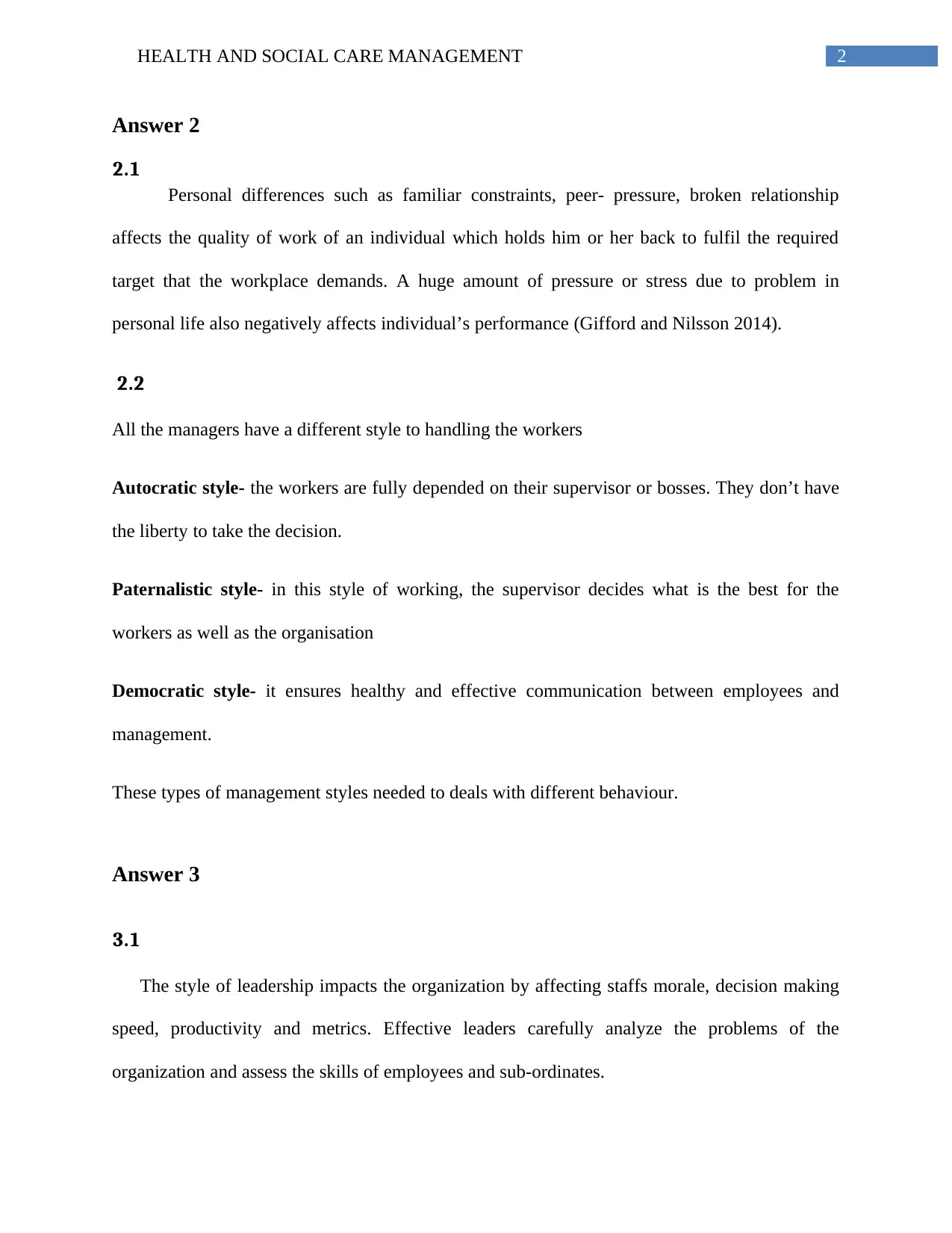
2HEALTH AND SOCIAL CARE MANAGEMENT
Answer 2
2.1
Personal differences such as familiar constraints, peer- pressure, broken relationship
affects the quality of work of an individual which holds him or her back to fulfil the required
target that the workplace demands. A huge amount of pressure or stress due to problem in
personal life also negatively affects individual’s performance (Gifford and Nilsson 2014).
2.2
All the managers have a different style to handling the workers
Autocratic style- the workers are fully depended on their supervisor or bosses. They don’t have
the liberty to take the decision.
Paternalistic style- in this style of working, the supervisor decides what is the best for the
workers as well as the organisation
Democratic style- it ensures healthy and effective communication between employees and
management.
These types of management styles needed to deals with different behaviour.
Answer 3
3.1
The style of leadership impacts the organization by affecting staffs morale, decision making
speed, productivity and metrics. Effective leaders carefully analyze the problems of the
organization and assess the skills of employees and sub-ordinates.
Answer 2
2.1
Personal differences such as familiar constraints, peer- pressure, broken relationship
affects the quality of work of an individual which holds him or her back to fulfil the required
target that the workplace demands. A huge amount of pressure or stress due to problem in
personal life also negatively affects individual’s performance (Gifford and Nilsson 2014).
2.2
All the managers have a different style to handling the workers
Autocratic style- the workers are fully depended on their supervisor or bosses. They don’t have
the liberty to take the decision.
Paternalistic style- in this style of working, the supervisor decides what is the best for the
workers as well as the organisation
Democratic style- it ensures healthy and effective communication between employees and
management.
These types of management styles needed to deals with different behaviour.
Answer 3
3.1
The style of leadership impacts the organization by affecting staffs morale, decision making
speed, productivity and metrics. Effective leaders carefully analyze the problems of the
organization and assess the skills of employees and sub-ordinates.
⊘ This is a preview!⊘
Do you want full access?
Subscribe today to unlock all pages.

Trusted by 1+ million students worldwide
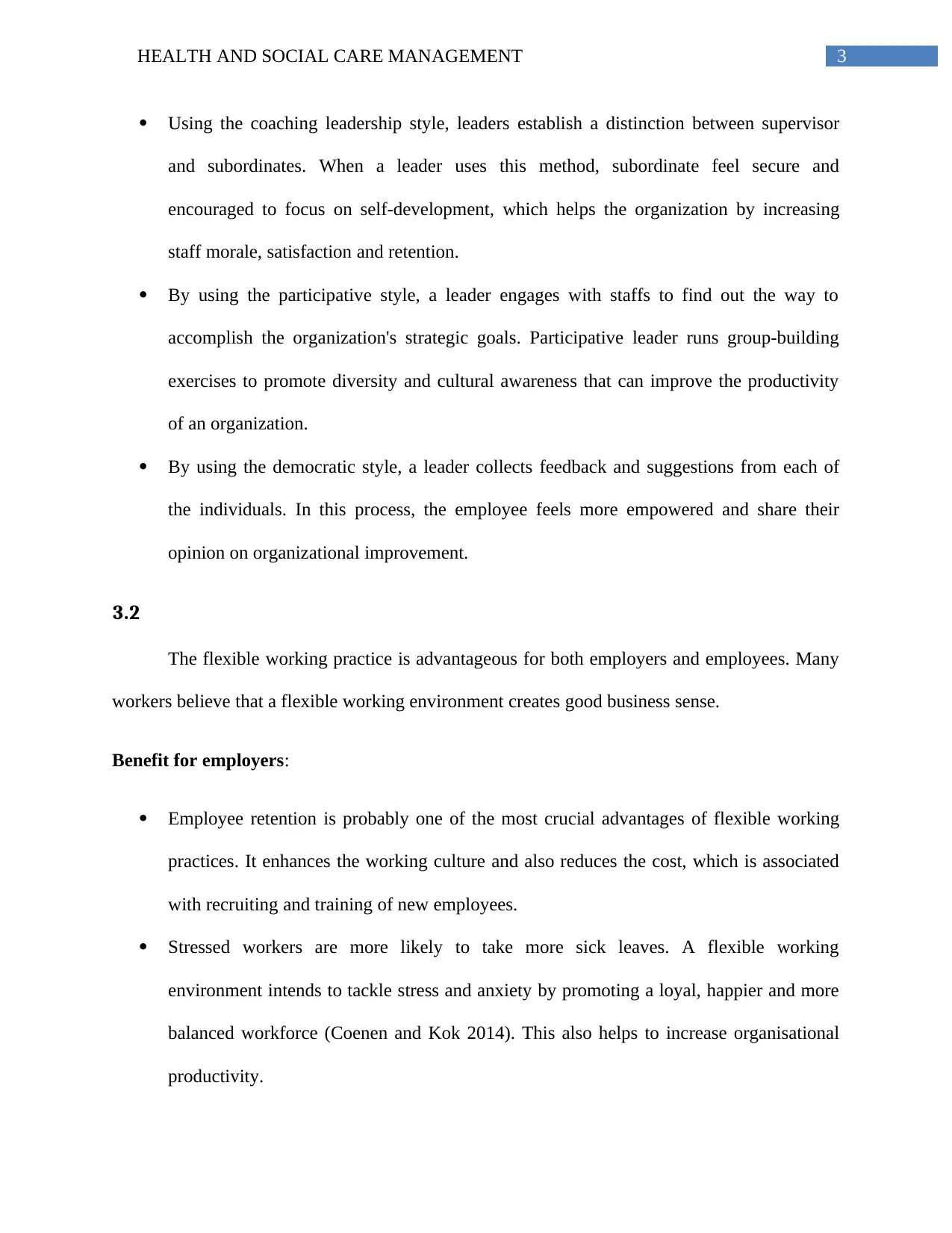
3HEALTH AND SOCIAL CARE MANAGEMENT
Using the coaching leadership style, leaders establish a distinction between supervisor
and subordinates. When a leader uses this method, subordinate feel secure and
encouraged to focus on self-development, which helps the organization by increasing
staff morale, satisfaction and retention.
By using the participative style, a leader engages with staffs to find out the way to
accomplish the organization's strategic goals. Participative leader runs group-building
exercises to promote diversity and cultural awareness that can improve the productivity
of an organization.
By using the democratic style, a leader collects feedback and suggestions from each of
the individuals. In this process, the employee feels more empowered and share their
opinion on organizational improvement.
3.2
The flexible working practice is advantageous for both employers and employees. Many
workers believe that a flexible working environment creates good business sense.
Benefit for employers:
Employee retention is probably one of the most crucial advantages of flexible working
practices. It enhances the working culture and also reduces the cost, which is associated
with recruiting and training of new employees.
Stressed workers are more likely to take more sick leaves. A flexible working
environment intends to tackle stress and anxiety by promoting a loyal, happier and more
balanced workforce (Coenen and Kok 2014). This also helps to increase organisational
productivity.
Using the coaching leadership style, leaders establish a distinction between supervisor
and subordinates. When a leader uses this method, subordinate feel secure and
encouraged to focus on self-development, which helps the organization by increasing
staff morale, satisfaction and retention.
By using the participative style, a leader engages with staffs to find out the way to
accomplish the organization's strategic goals. Participative leader runs group-building
exercises to promote diversity and cultural awareness that can improve the productivity
of an organization.
By using the democratic style, a leader collects feedback and suggestions from each of
the individuals. In this process, the employee feels more empowered and share their
opinion on organizational improvement.
3.2
The flexible working practice is advantageous for both employers and employees. Many
workers believe that a flexible working environment creates good business sense.
Benefit for employers:
Employee retention is probably one of the most crucial advantages of flexible working
practices. It enhances the working culture and also reduces the cost, which is associated
with recruiting and training of new employees.
Stressed workers are more likely to take more sick leaves. A flexible working
environment intends to tackle stress and anxiety by promoting a loyal, happier and more
balanced workforce (Coenen and Kok 2014). This also helps to increase organisational
productivity.
Paraphrase This Document
Need a fresh take? Get an instant paraphrase of this document with our AI Paraphraser
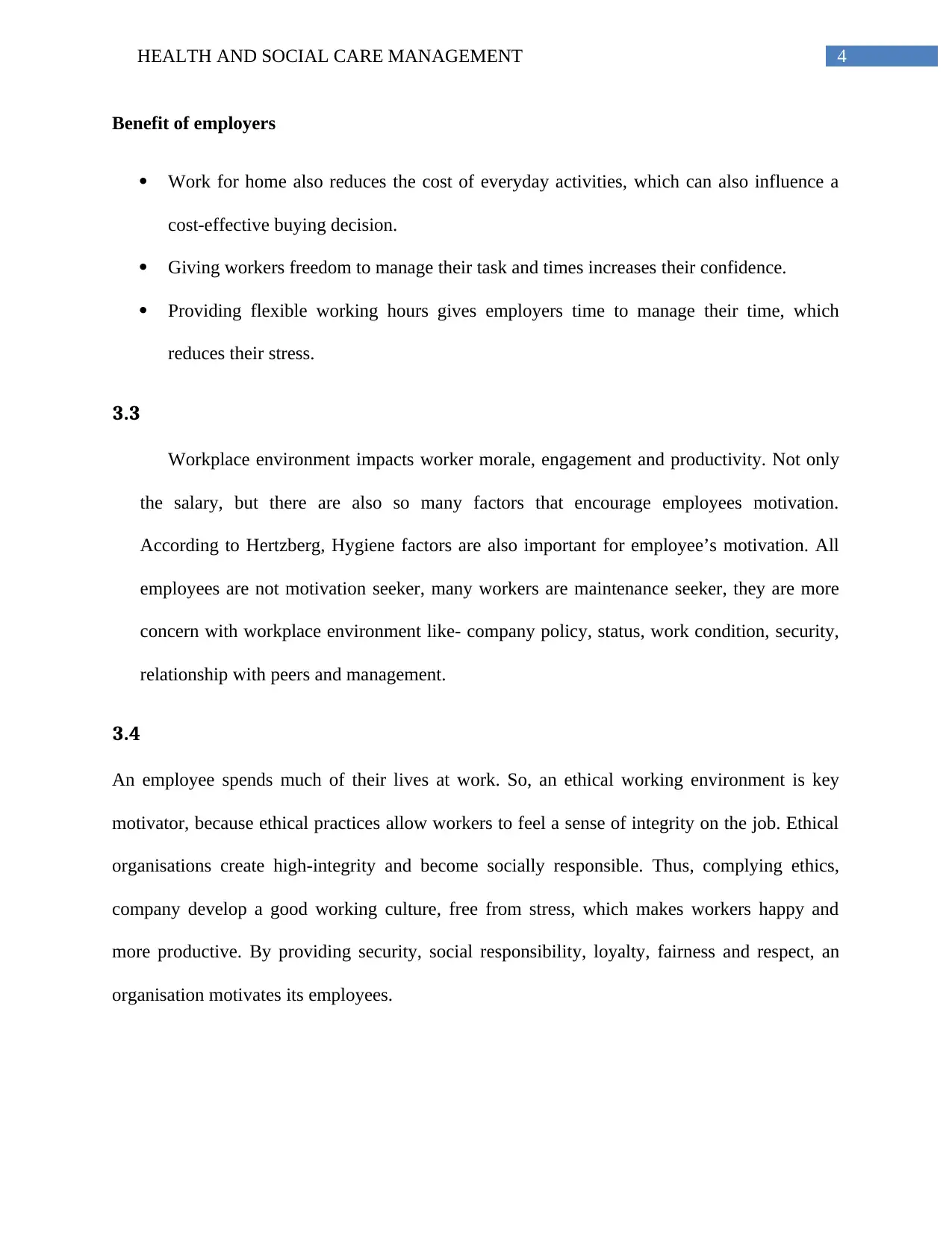
4HEALTH AND SOCIAL CARE MANAGEMENT
Benefit of employers
Work for home also reduces the cost of everyday activities, which can also influence a
cost-effective buying decision.
Giving workers freedom to manage their task and times increases their confidence.
Providing flexible working hours gives employers time to manage their time, which
reduces their stress.
3.3
Workplace environment impacts worker morale, engagement and productivity. Not only
the salary, but there are also so many factors that encourage employees motivation.
According to Hertzberg, Hygiene factors are also important for employee’s motivation. All
employees are not motivation seeker, many workers are maintenance seeker, they are more
concern with workplace environment like- company policy, status, work condition, security,
relationship with peers and management.
3.4
An employee spends much of their lives at work. So, an ethical working environment is key
motivator, because ethical practices allow workers to feel a sense of integrity on the job. Ethical
organisations create high-integrity and become socially responsible. Thus, complying ethics,
company develop a good working culture, free from stress, which makes workers happy and
more productive. By providing security, social responsibility, loyalty, fairness and respect, an
organisation motivates its employees.
Benefit of employers
Work for home also reduces the cost of everyday activities, which can also influence a
cost-effective buying decision.
Giving workers freedom to manage their task and times increases their confidence.
Providing flexible working hours gives employers time to manage their time, which
reduces their stress.
3.3
Workplace environment impacts worker morale, engagement and productivity. Not only
the salary, but there are also so many factors that encourage employees motivation.
According to Hertzberg, Hygiene factors are also important for employee’s motivation. All
employees are not motivation seeker, many workers are maintenance seeker, they are more
concern with workplace environment like- company policy, status, work condition, security,
relationship with peers and management.
3.4
An employee spends much of their lives at work. So, an ethical working environment is key
motivator, because ethical practices allow workers to feel a sense of integrity on the job. Ethical
organisations create high-integrity and become socially responsible. Thus, complying ethics,
company develop a good working culture, free from stress, which makes workers happy and
more productive. By providing security, social responsibility, loyalty, fairness and respect, an
organisation motivates its employees.
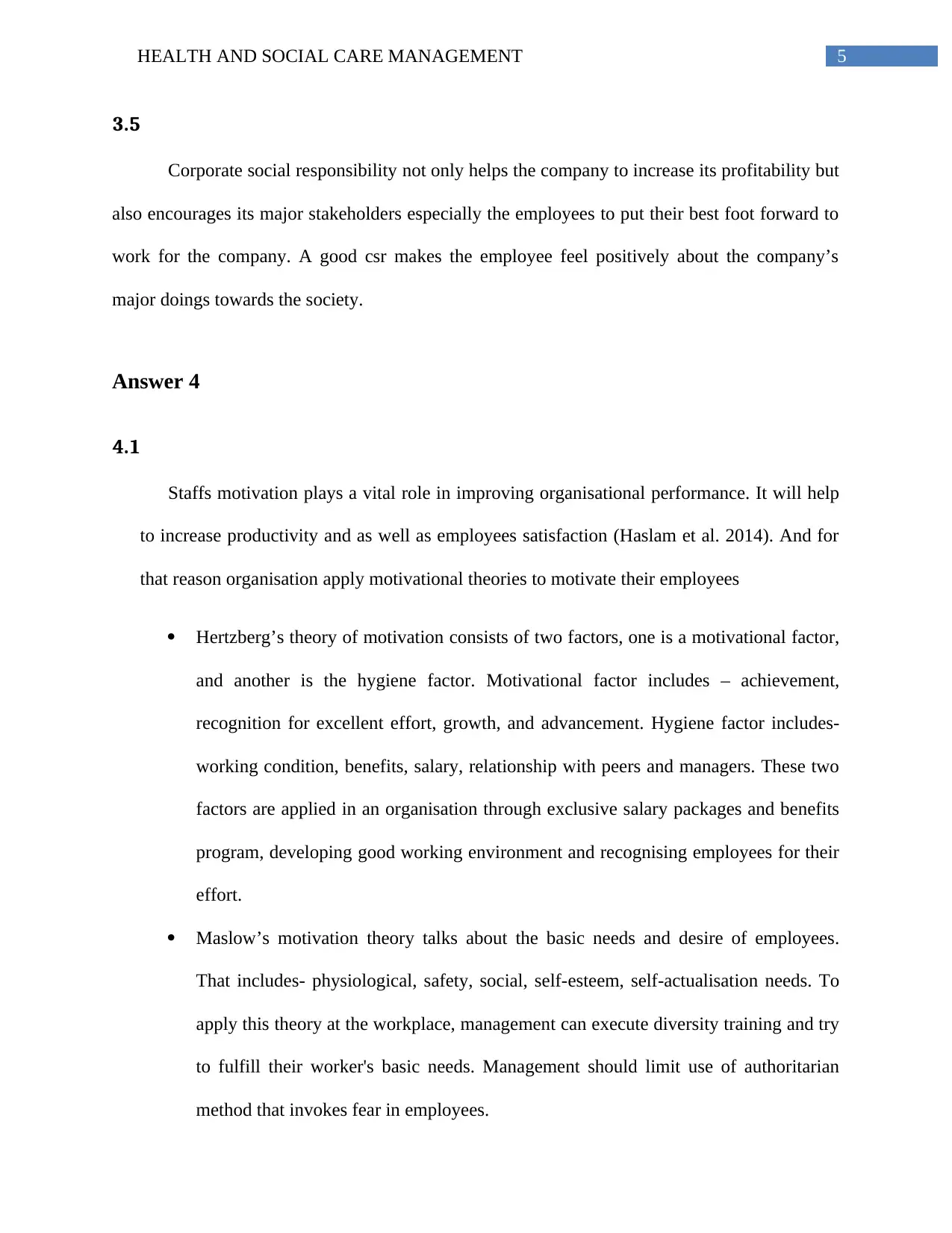
5HEALTH AND SOCIAL CARE MANAGEMENT
3.5
Corporate social responsibility not only helps the company to increase its profitability but
also encourages its major stakeholders especially the employees to put their best foot forward to
work for the company. A good csr makes the employee feel positively about the company’s
major doings towards the society.
Answer 4
4.1
Staffs motivation plays a vital role in improving organisational performance. It will help
to increase productivity and as well as employees satisfaction (Haslam et al. 2014). And for
that reason organisation apply motivational theories to motivate their employees
Hertzberg’s theory of motivation consists of two factors, one is a motivational factor,
and another is the hygiene factor. Motivational factor includes – achievement,
recognition for excellent effort, growth, and advancement. Hygiene factor includes-
working condition, benefits, salary, relationship with peers and managers. These two
factors are applied in an organisation through exclusive salary packages and benefits
program, developing good working environment and recognising employees for their
effort.
Maslow’s motivation theory talks about the basic needs and desire of employees.
That includes- physiological, safety, social, self-esteem, self-actualisation needs. To
apply this theory at the workplace, management can execute diversity training and try
to fulfill their worker's basic needs. Management should limit use of authoritarian
method that invokes fear in employees.
3.5
Corporate social responsibility not only helps the company to increase its profitability but
also encourages its major stakeholders especially the employees to put their best foot forward to
work for the company. A good csr makes the employee feel positively about the company’s
major doings towards the society.
Answer 4
4.1
Staffs motivation plays a vital role in improving organisational performance. It will help
to increase productivity and as well as employees satisfaction (Haslam et al. 2014). And for
that reason organisation apply motivational theories to motivate their employees
Hertzberg’s theory of motivation consists of two factors, one is a motivational factor,
and another is the hygiene factor. Motivational factor includes – achievement,
recognition for excellent effort, growth, and advancement. Hygiene factor includes-
working condition, benefits, salary, relationship with peers and managers. These two
factors are applied in an organisation through exclusive salary packages and benefits
program, developing good working environment and recognising employees for their
effort.
Maslow’s motivation theory talks about the basic needs and desire of employees.
That includes- physiological, safety, social, self-esteem, self-actualisation needs. To
apply this theory at the workplace, management can execute diversity training and try
to fulfill their worker's basic needs. Management should limit use of authoritarian
method that invokes fear in employees.
⊘ This is a preview!⊘
Do you want full access?
Subscribe today to unlock all pages.

Trusted by 1+ million students worldwide
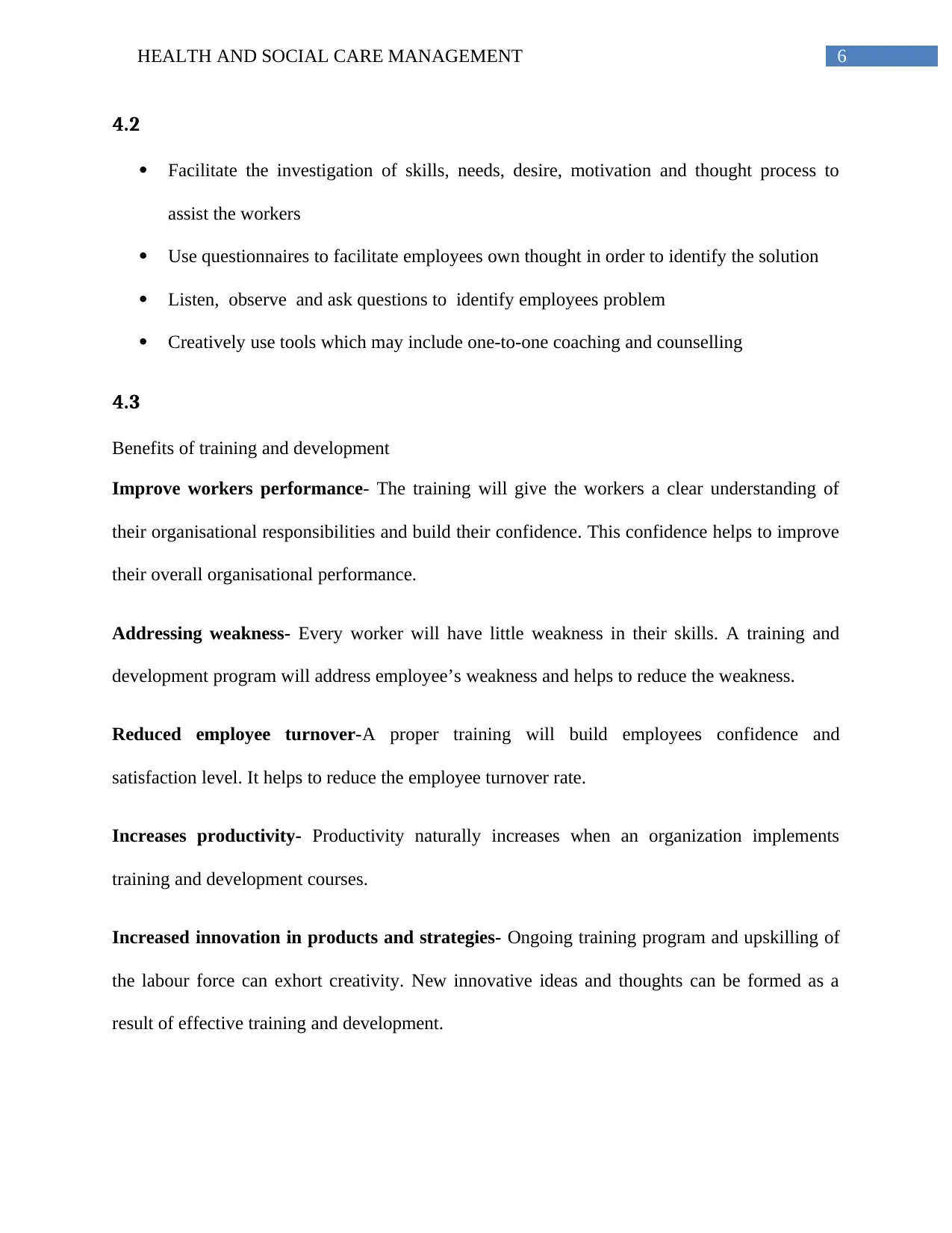
6HEALTH AND SOCIAL CARE MANAGEMENT
4.2
Facilitate the investigation of skills, needs, desire, motivation and thought process to
assist the workers
Use questionnaires to facilitate employees own thought in order to identify the solution
Listen, observe and ask questions to identify employees problem
Creatively use tools which may include one-to-one coaching and counselling
4.3
Benefits of training and development
Improve workers performance- The training will give the workers a clear understanding of
their organisational responsibilities and build their confidence. This confidence helps to improve
their overall organisational performance.
Addressing weakness- Every worker will have little weakness in their skills. A training and
development program will address employee’s weakness and helps to reduce the weakness.
Reduced employee turnover-A proper training will build employees confidence and
satisfaction level. It helps to reduce the employee turnover rate.
Increases productivity- Productivity naturally increases when an organization implements
training and development courses.
Increased innovation in products and strategies- Ongoing training program and upskilling of
the labour force can exhort creativity. New innovative ideas and thoughts can be formed as a
result of effective training and development.
4.2
Facilitate the investigation of skills, needs, desire, motivation and thought process to
assist the workers
Use questionnaires to facilitate employees own thought in order to identify the solution
Listen, observe and ask questions to identify employees problem
Creatively use tools which may include one-to-one coaching and counselling
4.3
Benefits of training and development
Improve workers performance- The training will give the workers a clear understanding of
their organisational responsibilities and build their confidence. This confidence helps to improve
their overall organisational performance.
Addressing weakness- Every worker will have little weakness in their skills. A training and
development program will address employee’s weakness and helps to reduce the weakness.
Reduced employee turnover-A proper training will build employees confidence and
satisfaction level. It helps to reduce the employee turnover rate.
Increases productivity- Productivity naturally increases when an organization implements
training and development courses.
Increased innovation in products and strategies- Ongoing training program and upskilling of
the labour force can exhort creativity. New innovative ideas and thoughts can be formed as a
result of effective training and development.
Paraphrase This Document
Need a fresh take? Get an instant paraphrase of this document with our AI Paraphraser
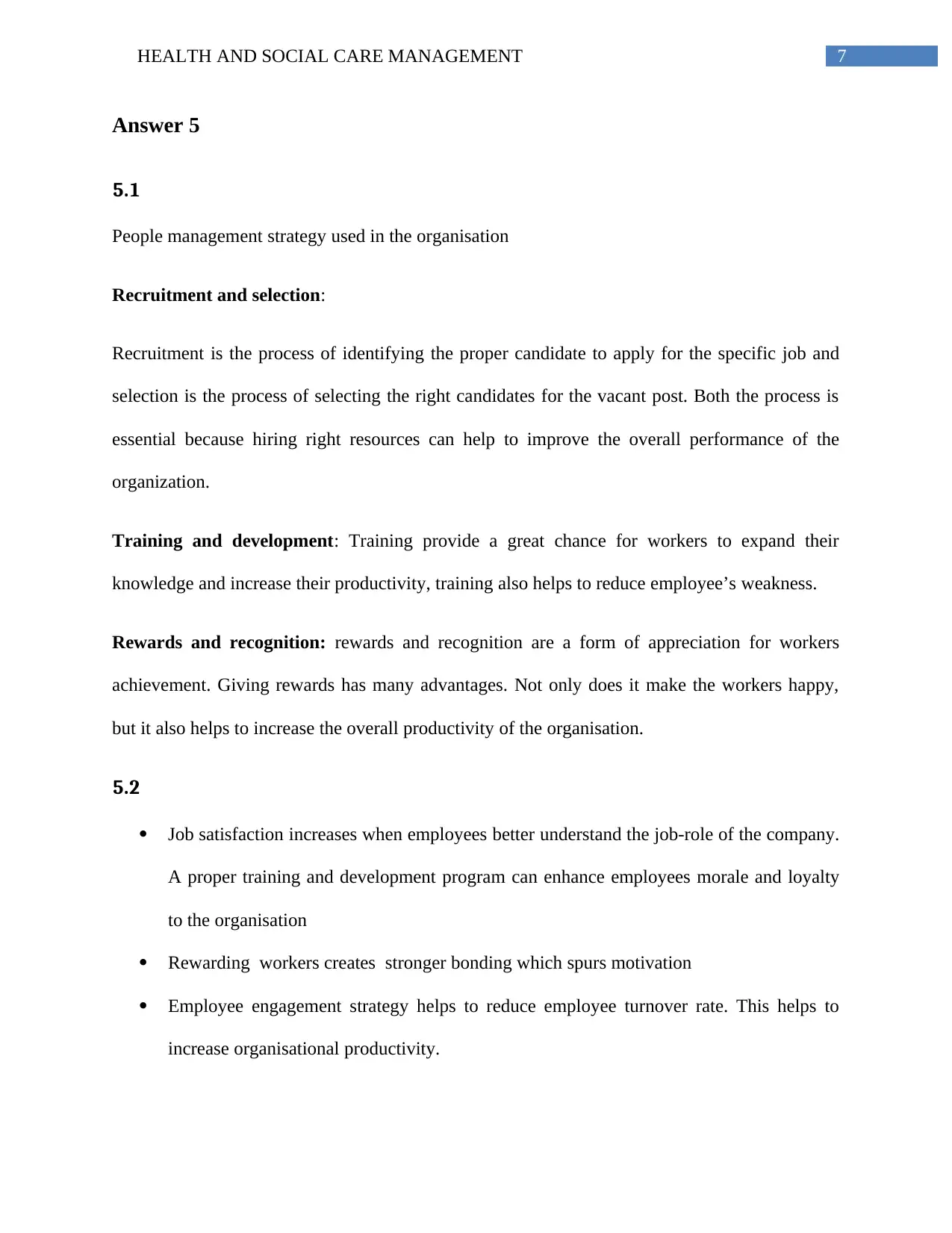
7HEALTH AND SOCIAL CARE MANAGEMENT
Answer 5
5.1
People management strategy used in the organisation
Recruitment and selection:
Recruitment is the process of identifying the proper candidate to apply for the specific job and
selection is the process of selecting the right candidates for the vacant post. Both the process is
essential because hiring right resources can help to improve the overall performance of the
organization.
Training and development: Training provide a great chance for workers to expand their
knowledge and increase their productivity, training also helps to reduce employee’s weakness.
Rewards and recognition: rewards and recognition are a form of appreciation for workers
achievement. Giving rewards has many advantages. Not only does it make the workers happy,
but it also helps to increase the overall productivity of the organisation.
5.2
Job satisfaction increases when employees better understand the job-role of the company.
A proper training and development program can enhance employees morale and loyalty
to the organisation
Rewarding workers creates stronger bonding which spurs motivation
Employee engagement strategy helps to reduce employee turnover rate. This helps to
increase organisational productivity.
Answer 5
5.1
People management strategy used in the organisation
Recruitment and selection:
Recruitment is the process of identifying the proper candidate to apply for the specific job and
selection is the process of selecting the right candidates for the vacant post. Both the process is
essential because hiring right resources can help to improve the overall performance of the
organization.
Training and development: Training provide a great chance for workers to expand their
knowledge and increase their productivity, training also helps to reduce employee’s weakness.
Rewards and recognition: rewards and recognition are a form of appreciation for workers
achievement. Giving rewards has many advantages. Not only does it make the workers happy,
but it also helps to increase the overall productivity of the organisation.
5.2
Job satisfaction increases when employees better understand the job-role of the company.
A proper training and development program can enhance employees morale and loyalty
to the organisation
Rewarding workers creates stronger bonding which spurs motivation
Employee engagement strategy helps to reduce employee turnover rate. This helps to
increase organisational productivity.
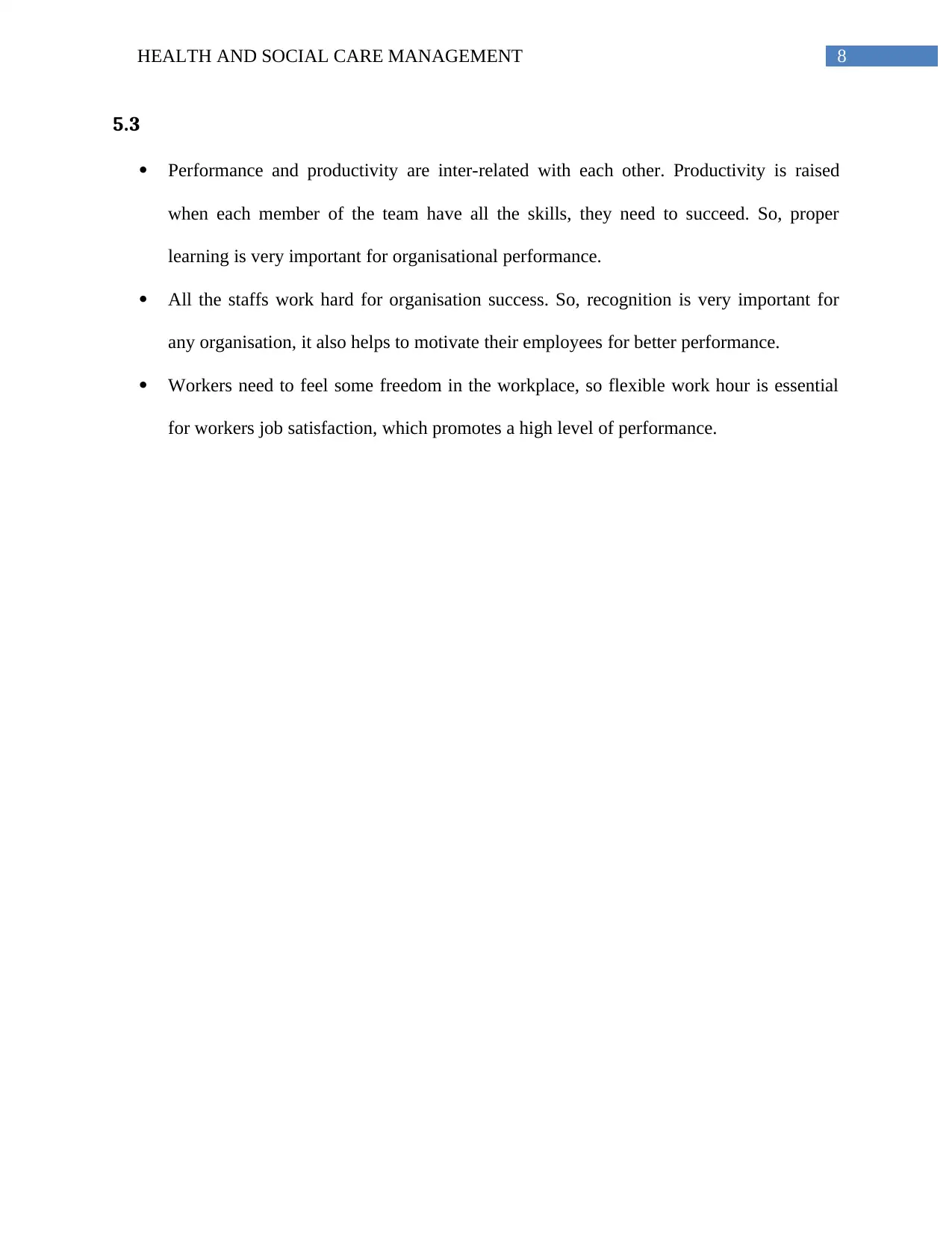
8HEALTH AND SOCIAL CARE MANAGEMENT
5.3
Performance and productivity are inter-related with each other. Productivity is raised
when each member of the team have all the skills, they need to succeed. So, proper
learning is very important for organisational performance.
All the staffs work hard for organisation success. So, recognition is very important for
any organisation, it also helps to motivate their employees for better performance.
Workers need to feel some freedom in the workplace, so flexible work hour is essential
for workers job satisfaction, which promotes a high level of performance.
5.3
Performance and productivity are inter-related with each other. Productivity is raised
when each member of the team have all the skills, they need to succeed. So, proper
learning is very important for organisational performance.
All the staffs work hard for organisation success. So, recognition is very important for
any organisation, it also helps to motivate their employees for better performance.
Workers need to feel some freedom in the workplace, so flexible work hour is essential
for workers job satisfaction, which promotes a high level of performance.
⊘ This is a preview!⊘
Do you want full access?
Subscribe today to unlock all pages.

Trusted by 1+ million students worldwide
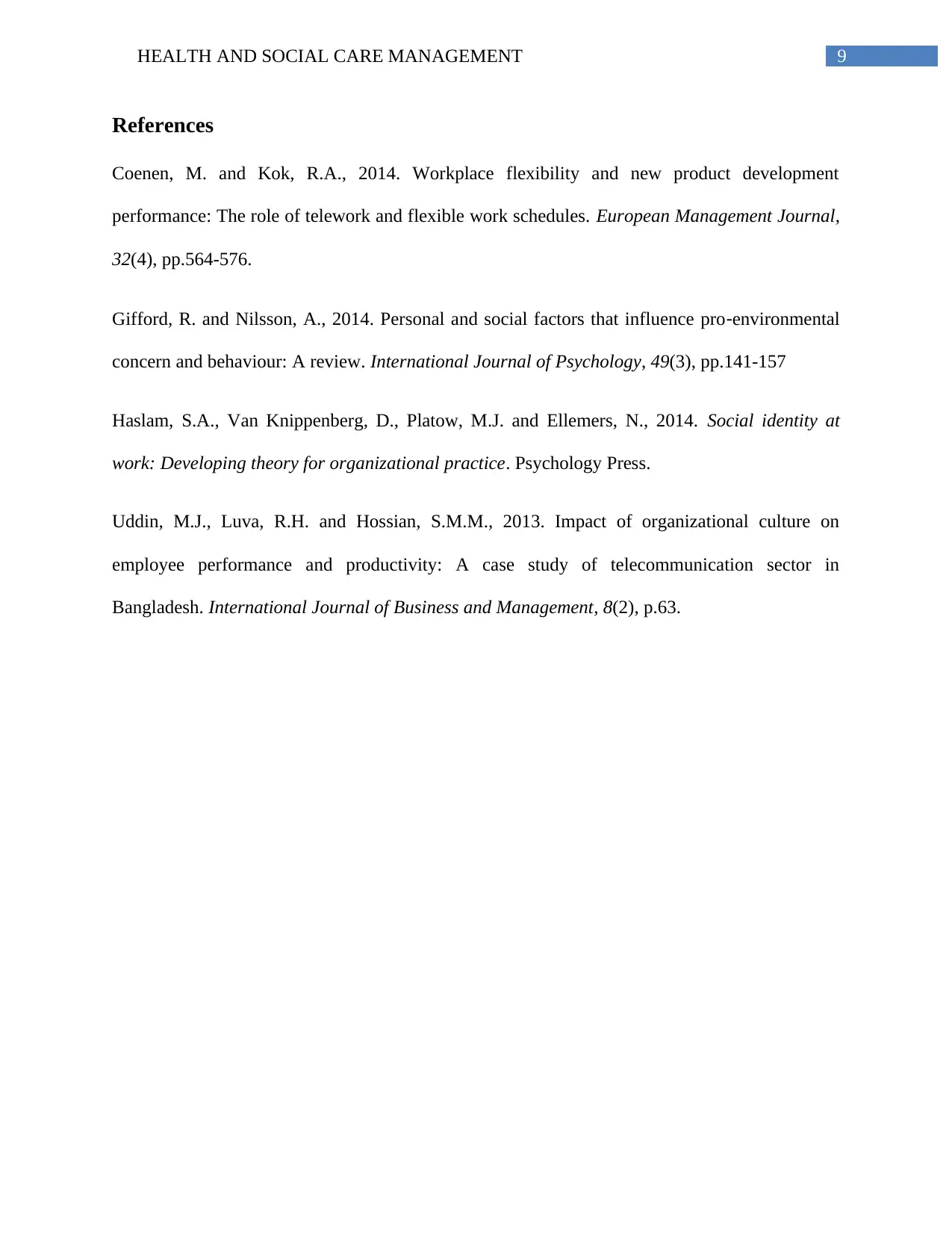
9HEALTH AND SOCIAL CARE MANAGEMENT
References
Coenen, M. and Kok, R.A., 2014. Workplace flexibility and new product development
performance: The role of telework and flexible work schedules. European Management Journal,
32(4), pp.564-576.
Gifford, R. and Nilsson, A., 2014. Personal and social factors that influence pro‐environmental
concern and behaviour: A review. International Journal of Psychology, 49(3), pp.141-157
Haslam, S.A., Van Knippenberg, D., Platow, M.J. and Ellemers, N., 2014. Social identity at
work: Developing theory for organizational practice. Psychology Press.
Uddin, M.J., Luva, R.H. and Hossian, S.M.M., 2013. Impact of organizational culture on
employee performance and productivity: A case study of telecommunication sector in
Bangladesh. International Journal of Business and Management, 8(2), p.63.
References
Coenen, M. and Kok, R.A., 2014. Workplace flexibility and new product development
performance: The role of telework and flexible work schedules. European Management Journal,
32(4), pp.564-576.
Gifford, R. and Nilsson, A., 2014. Personal and social factors that influence pro‐environmental
concern and behaviour: A review. International Journal of Psychology, 49(3), pp.141-157
Haslam, S.A., Van Knippenberg, D., Platow, M.J. and Ellemers, N., 2014. Social identity at
work: Developing theory for organizational practice. Psychology Press.
Uddin, M.J., Luva, R.H. and Hossian, S.M.M., 2013. Impact of organizational culture on
employee performance and productivity: A case study of telecommunication sector in
Bangladesh. International Journal of Business and Management, 8(2), p.63.
1 out of 10
Related Documents
Your All-in-One AI-Powered Toolkit for Academic Success.
+13062052269
info@desklib.com
Available 24*7 on WhatsApp / Email
![[object Object]](/_next/static/media/star-bottom.7253800d.svg)
Unlock your academic potential
Copyright © 2020–2025 A2Z Services. All Rights Reserved. Developed and managed by ZUCOL.





